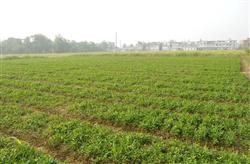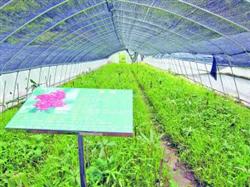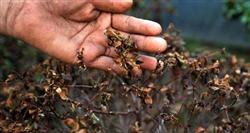How to cultivate Pinellia ternata

How to cultivate Pinellia ternata? Please give a detailed introduction that Pinellia ternata is a commonly used valuable traditional Chinese medicine, which mainly depends on the collection of wild resources to provide commodities. In recent years, due to the changes of environment, climate and resources, the contradiction between supply and demand has become increasingly tense. Due to the slow development of planting, the market has been in short supply, and prices have always been stable and rising. In many places, Pinellia ternata has been used instead of Pinellia ternata. Jiangxi, Guangxi and other southern provinces have planted Pinellia ternata, and the state has repeatedly ordered Pinellia ternata as counterfeit products, and pharmaceutical companies are prohibited from using counterfeit water instead of Pinellia ternata. Due to various reasons, its wild resources are in short supply. Due to low fecundity and variety degradation, artificial cultivation limits the improvement of output and quality, unable to supply strong market demand in time, and the market volume decreases year by year. However, the domestic drug consumption and export volume have increased significantly year by year, and its selling price is getting higher and higher. In 2005, the drug market sold 550.65 yuan per kilogram, which increased by 33.3% compared with 45 yuan. There is a tight demand for both export and domestic sales, and there is no supply of more goods, which has become a hot variety in the pharmaceutical market, and the market and planting prospects are good. The traditional method is used to plant Pinellia ternata with a fresh tuber yield of 500,750kg per mu, a drying rate of 25% to 30%, and an annual yield of 125kg to 200kg. According to the practical experience of high yield in the producing area, the average tuber yield of the high-yield field is 850kg to 1500kg, and the yield is increased by 50% to 100%. The output value per mu is more than 10000 yuan, and the benefit is considerable. Therefore, in order to obtain higher yield and high benefit in planting Pinellia ternata, in addition to routine field management, we must also grasp the following key links: according to the biological characteristics of Pinellia ternata, develop production according to local conditions. Pinellia ternata likes a warm, humid climate, can withstand cold and shade, but is not resistant to drought and is afraid of strong light. Taking advantage of this characteristic, Pinellia ternata can be interplanted in the gentle slope of half-shaded and half-sunny mountains, or in wheat fields or broad-leaved fruit forests, or intercropped with tall plants such as corn, rape, sorghum, beans and other tall plants, so that Pinellia ternata can be managed while managing crops or economic forest fruits, which not only makes rational use of the land, but also increases the comprehensive benefit. Good seed is an important guarantee for planting Pinellia ternata to obtain high yield. So what are the conditions that determine the quality of good seeds? First of all, excellent individual plants with pure varieties, no diseases and insect pests and strong growth and development should be selected as seed collection mother plants. Secondly, the mother plant of seed collection should be bred alone, and the management of water and fertilizer should be strengthened. Thirdly, in order to prevent the varieties from being mixed, it is necessary to collect and store them separately. Finally, tubers with mature, full, large and heavy grains should be harvested in time for planting. The fine seed bulbs of Pinellia ternata were carefully selected and cultured in tissue by modern biological means, the rapid propagation system of superior seed clones of Pinellia ternata was established, and the varieties of Pinellia ternata with excellent characters were screened out, which can not only produce a large number of fine Pinellia ternata seedlings, but also shorten the growth period in the field. Combined with the propagation of bulbs and tubers, the propagation coefficient was improved. According to the experiment, under the condition of 20-25 ℃, when most of the coleoptiles were white, the seedlings were planted and covered with plastic film, which were 30 days earlier than those without plastic film mulching, and those without plastic film mulching were 25 days earlier. At the same time, the yield of budding mulch was 52.6% higher than that of the control, and the yield of non-budding mulch was 29.8% higher than that of the control. After the bud was accelerated and planted, the internal physiological changes of Pinellia ternata were completed ahead of time, and the ground temperature increased and reached the temperature needed for seedling emergence ahead of time, and the bud grew out of the ground quickly. In addition to preserving soil moisture and increasing temperature, budding mulch not only loosens the soil, but also has good air permeability, which is more conducive to the growth and development of root system, makes the plant resistant to drought and waterlogging, and always maintains exuberant absorption function and physiological function, which lays the foundation for the increase of Pinellia ternata tuber and high yield. The plastic film used can be ordinary agricultural plastic film (thickness 0.014 mm) or high density film (thickness 0.008 mm). When covering the film, make the film flat and close to the ridge of the border, compacted with soil, so that it is tight, flat and strict. When the temperature is stable at 15: 18 ℃ and the emergence of seedlings is about 50%, the plastic film should be removed to prevent the seedlings from being damaged by high temperature in the film. The seedlings should be refined before removing the film. The method is to open the ventilation and heat dissipation from both ends of the bed at noon, seal it in the evening, and then remove it all after a few days in a row. When the high temperature season gradually entered in late June, how to keep the border moist and delay the withering time of the aboveground part of Pinellia ternata as far as possible is an important measure to increase the yield of Pinellia ternata. According to the experiment, rice and wheat straw (chaff) were covered in the middle of May and June every year, and the seedling was only 5% in late July, growing well, while 78% in the control group. In this way, the mulching relatively prolonged the growth period, the photocooperation period was also relatively prolonged, the photosynthate accumulated more in the tuber, and the tuber grew larger and the yield was higher, which was 123.78% higher than that of the control. In addition, the number of weeds in the covered area was significantly lower than that in the uncovered control area, and the incidence of leaf rot decreased significantly, which was also an important reason for the yield increase of Pinellia ternata. If Rain Water is big, the rainy season is continuous, and the soil moisture is too much, not only can not cover the second time, but also the wheat straw covered by the first time should be removed in time to prevent the underground tuber from rotting and reducing the yield. The plant of Pinellia ternata is short, so it is necessary to loosen the soil and weed frequently during the growth period to avoid grass shortage. The depth of intertillage should not exceed 5 cm to avoid root injury. Because the root of Pinellia ternata grows around the tuber, and its root system is concentrated in the topsoil layer of 12cm to 15cm, the ploughing should be shallow rather than deep, except early, small and small. Planted in early spring of Pinellia ternata and covered with plastic film, at the same time of its emergence, more than 10 kinds of weeds were also unearthed, such as Equisetum equisetifolia, Euphorbia angustifolia, Euphorbia angustifolia, Amaranth, Amaranth, Gray vegetable, Portulaca oleracea and so on. it often causes seedling emergence and difficulties in growth and development after opening the film, affecting the yield of Pinellia ternata. Therefore, Acetochlor can be used to control pre-bud weeds of Pinellia ternata, and then covered with plastic film after spraying herbicide on the ground in early spring, which has a good control effect on many kinds of weeds (the specific usage and dosage is operated according to the drug instructions). In addition, in artificial cultivation of Pinellia ternata, different herbicides can be selected according to different seasons, the herbicide of spring sowing Pinellia ternata should be selected, and the herbicide of spring sowing and Acetochlor can be selected. The practice shows that spraying sodium sulfite solution during the period of high temperature and drought can increase the yield of Pinellia ternata. Because when the temperature of Pinellia ternata lasts as high as 30 ℃ in summer, the respiration of Pinellia ternata is too strong due to high temperature and strong light, which consumes more substances than that accumulated by photosynthesis, resulting in the destruction of cell protoplast structure and "seedling collapse". As far as Pinellia ternata production is concerned, "inverted seedling" shortens the growth period of Pinellia ternata and seriously affects the yield of Pinellia ternata. Therefore, taking measures to delay or reduce the "falling seedlings" of Pinellia ternata in summer is an important condition to realize the high yield and high quality of Pinellia ternata. In addition to adopting appropriate shading and sprinkler irrigation to reduce light intensity, air temperature and ground temperature, 0.01% solution of plant respiratory inhibitor sodium sulfite can also be sprayed, and a mixture of 0.01% sodium sulfite, 0.2% urea and 2% superphosphate can also be sprayed to inhibit respiration of Pinellia ternata and reduce the consumption of photosynthates, thus delaying and reducing "falling seedlings", which can significantly increase production. Click to get more planting techniques of Pinellia ternata
- Prev

How to plant Pinellia ternata in greenhouse?
How to plant Pinellia ternata in greenhouse? Please introduce the method of Pinellia ternata, which is the alias of Pinellia ternata, Pinellia ternata, Pinellia ternata and Ma Yuguo, which are commonly used Chinese medicinal materials and are distributed in the north and south of China. In recent years, due to the reclamation and utilization of barren mountains and the extensive use of herbicides in farmland, the ecological environment has been destroyed, resources have been reduced year by year, and the price.
- Next

Why do potted azaleas die?
Why do potted azaleas die? Please introduce the reasons and control methods of potted rhododendron wilting and dying, which makes the flower growers feel sorry. Now the reasons and countermeasures are analyzed as follows: first, the light time is not big and beautiful, the florescence is long, and sufficient sunlight is required, such as indoor viewing, photosynthesis.
Related
- Fuxing push coffee new agricultural production and marketing class: lack of small-scale processing plants
- Jujube rice field leisure farm deep ploughing Yilan for five years to create a space for organic food and play
- Nongyu Farm-A trial of organic papaya for brave women with advanced technology
- Four points for attention in the prevention and control of diseases and insect pests of edible fungi
- How to add nutrient solution to Edible Fungi
- Is there any good way to control edible fungus mites?
- Open Inoculation Technology of Edible Fungi
- Is there any clever way to use fertilizer for edible fungus in winter?
- What agents are used to kill the pathogens of edible fungi in the mushroom shed?
- Rapid drying of Edible Fungi

